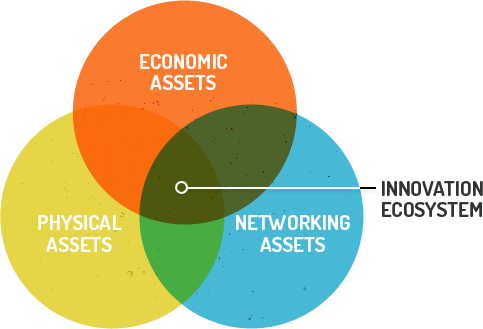Clever Cities! Innovation as a Leader in Urban Transformation
By Mark Graham
Date
August 25, 2017Our cities have historically been the centres of knowledge, with universities and colleges leading the way in innovation and research. This knowledge economy has borne fruits with global corporations, research institutes and Small and Medium Sized Enterprises (SMEs) throughout the late 20th Century and still gathers pace into the 21st Century. Driven by the growth of the knowledge economy and, critically, the need to retain students after their education is complete, cities are increasingly looking to technology and research to grow their economic base. This, coupled with changing global dynamics – increased urbanisation and centralised populations – and changing approaches to urbanism – through focus on live-work, mixed uses and increased desegregation of industries – has led to the rise of innovation activity in our cities.
Growing from an established American model, an Innovation District is considered to be a place where business, research and knowledge is collocated within an urban or sub-urban setting to grow innovation. Writing in the “The Rise of Innovation Districts”, Bruce Katz and Julie Wagner describe Innovation Districts as being “…connected by transit, powered by clean energy, wired for digital technology, and fuelled by caffeine.” – all ingredients to a vibrant urban place. A number of “Innovation Districts “are growing throughout the UK’s major cities, including Manchester, Liverpool, Sheffield, Glasgow, and London.

“All innovation districts contain economic, physical, and networking assets.” Image Credit: “The Rise of Innovation Districts” by Bruce Katz and Julie Wagner
Key to the delivery of these successful innovation districts are strategic links to both universities – providing links to research and knowledge – and businesses – providing links to jobs. Other key ingredients are successful links to public transport and active travel routes, high quality internet connection, access to services and amenities and an attractive, walkable environment – all ingredients that form healthy, sustainable and liveable communities. Locating these Districts in central urban areas creates the opportunity to foster innovation and entrepreneurial spirit. Collocating business, advanced manufacturing, science-based research and education within a high quality place will foster interaction, collaboration and ultimately innovative new ideas in order to promote economic growth in a city. This could be done through the creation of a range of different ‘networking assets’ including social public spaces and shared workspaces – creating a third place for interaction and creativity. This approach has been expressed in IBI’s work in Science Vale and the Sheffield Advanced Manufacturing District (AMID) where there is an Innovation Village with this third place at its heart, leading the innovation district.
This dynamic approach to urbanism has led to the creation of attractive, liveable and dynamic urban blocks and corridors, which attract a mix of uses and, critically, investors.
It is clear that innovation districts can play a significant role in shaping the places of the future, as well as providing critical links between the knowledge economies. It is critical that our cities and towns adapt and keep pace with the changing economic context in order to continue to thrive – placing innovation districts at their heart provides a significant opportunity to do this. As Edward Glaeser puts it in ‘Triumph of the City’; “Some places will…be left behind. Not every city will succeed, because not every city has been adept at adapting to the age of information, in which ideas are the ultimate creator of wealth.” IBI has certainly seen the benefits of this approach in our work at the Sheffield AMID, Sensor City (part of the Liverpool Knowledge Quarter), Blackpool Airport Enterprise Zone, and Science Vale where our work is driving new innovative approaches to economic and urban growth, and fundamentally creating better places.







